
10483
.pdf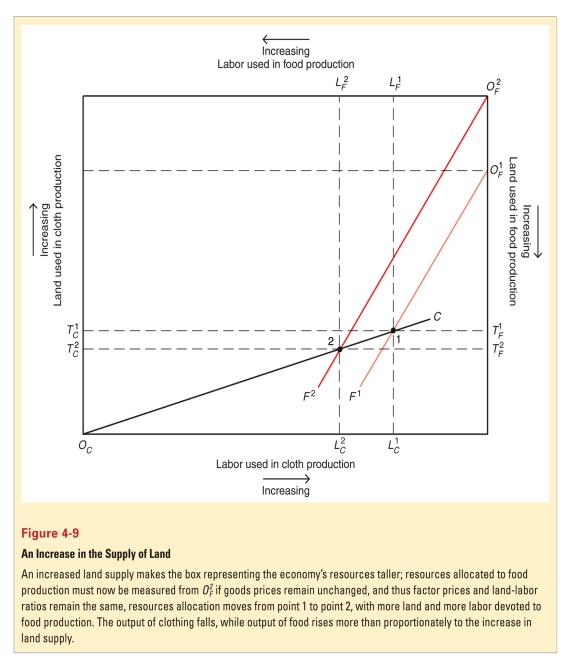
 How do output levels change when the economy’s resources change?
How do output levels change when the economy’s resources change?
 If we hold output prices constant as a factor of production increases, then the supply of the good that uses this factor intensively increases and the supply of the other good decreases.
If we hold output prices constant as a factor of production increases, then the supply of the good that uses this factor intensively increases and the supply of the other good decreases.
This proposition is called the Rybczynski theorem.
51
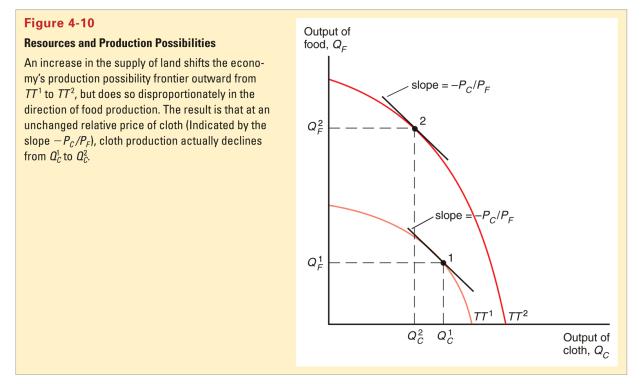
 A economy with a high ratio of land to labor is predicted to have a high output of food relative to cloth and a low price of food relative to cloth.
A economy with a high ratio of land to labor is predicted to have a high output of food relative to cloth and a low price of food relative to cloth.
It will be relatively efficient at (have a comparative advantage in) producing food.
It will be relatively inefficient at producing cloth.
 An economy will be relatively efficient at producing goods that are intensive in the factors of production in which the country is relatively well endowed.
An economy will be relatively efficient at producing goods that are intensive in the factors of production in which the country is relatively well endowed.
Trade in the Heckscher-Ohlin Model
 Suppose that the domestic country has an abundant amount of labor relative to the amount of land.
Suppose that the domestic country has an abundant amount of labor relative to the amount of land.
The domestic country is abundant in labor and the foreign country is abundant in land: L/T > L*/ T*
52
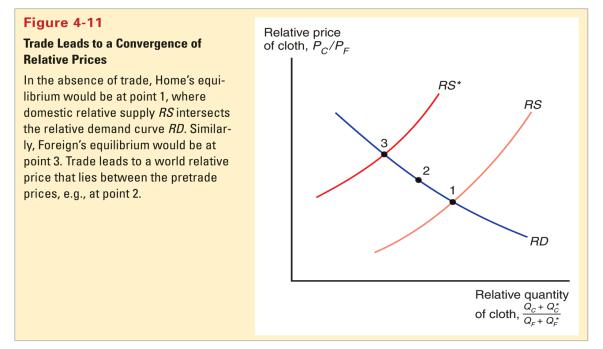
Likewise, the domestic country is scarce in land and the foreign country is scarce in labor.
However, the countries are assumed to have the same technology and same consumer tastes.
 Because the domestic country is abundant in labor, it will be relatively efficient at producing cloth because cloth is labor intensive.
Because the domestic country is abundant in labor, it will be relatively efficient at producing cloth because cloth is labor intensive.
 Since cloth is a labor intensive good, the domestic country’s PPF will allow a higher ratio of cloth to food relative to the foreign county’s
Since cloth is a labor intensive good, the domestic country’s PPF will allow a higher ratio of cloth to food relative to the foreign county’s
PPF.
 At each relative price, the domestic country will produce a higher ratio of cloth to food than the foreign country.
At each relative price, the domestic country will produce a higher ratio of cloth to food than the foreign country.
The domestic country will have a higher relative supply of cloth than the foreign country.
 Like the Ricardian model, the Heckscher-Ohlin model predicts a convergence of relative prices with trade.
Like the Ricardian model, the Heckscher-Ohlin model predicts a convergence of relative prices with trade.
 With trade, the relative price of cloth will rise in the domestic country and fall in the foreign country.
With trade, the relative price of cloth will rise in the domestic country and fall in the foreign country.
53

In the domestic country, the rise in the relative price of cloth leads to a rise in the relative production of cloth and a fall in relative consumption of cloth; the domestic country becomes an exporter of cloth and an importer of food.
The decline in the relative price of cloth in the foreign country leads it to become an importer of cloth and an exporter of food.
 An economy will be relatively efficient at (have a comparative advantage in) producing goods that are intensive in its abundant factors of production.
An economy will be relatively efficient at (have a comparative advantage in) producing goods that are intensive in its abundant factors of production.
 An economy will export goods that are intensive in its abundant factors of production and import goods that are intensive in its scarce factors of production.
An economy will export goods that are intensive in its abundant factors of production and import goods that are intensive in its scarce factors of production.
This proposition is called the Heckscher-Ohlin theorem
 Over time, the value of goods consumed is constrained to equal the value of goods produced for each country.
Over time, the value of goods consumed is constrained to equal the value of goods produced for each country.
PCDC + PFDF = PCQC + PFQF
where DC represents domestic consumption demand for cloth and DF represents domestic consumption demand for food
(DF – QF) = (PC /PF)(QC – DC)
(DF – QF) = (PC /PF)(QC – DC)
 This equation is the budget constraint for an economy, and it has a slope of – (PC /PF)
This equation is the budget constraint for an economy, and it has a slope of – (PC /PF)
(DF – QF) – (PC /PF)(QC – DC) = 0
54
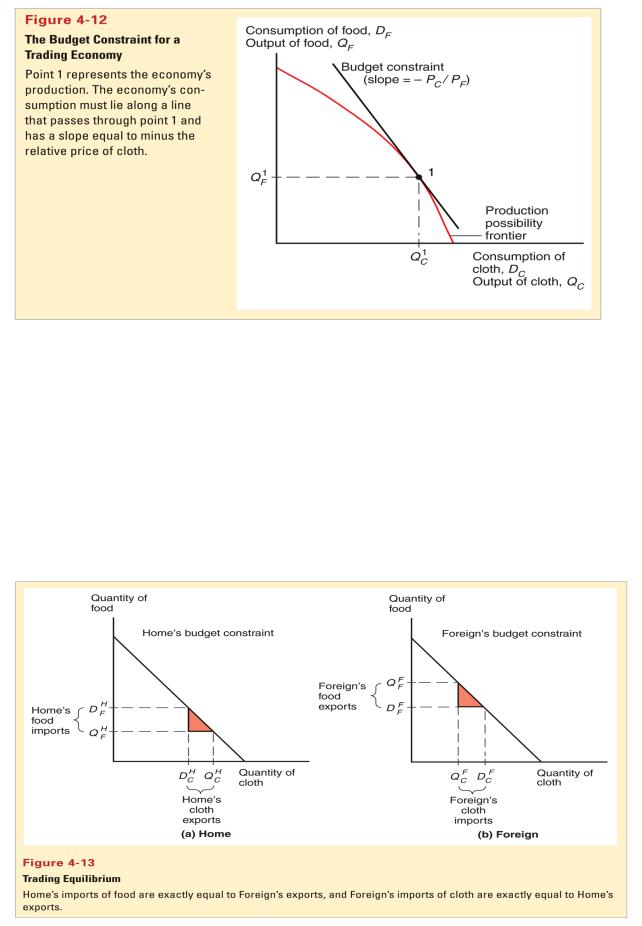
 Note that the budget constraint touches the PPF: a country can always afford to consume what it produces.
Note that the budget constraint touches the PPF: a country can always afford to consume what it produces.
 However, a country need not consume only the goods and services that it produces with trade.
However, a country need not consume only the goods and services that it produces with trade.
Exports and imports can be greater than zero.
 Furthermore, a country can afford to consume more of both goods with trade.
Furthermore, a country can afford to consume more of both goods with trade.
55
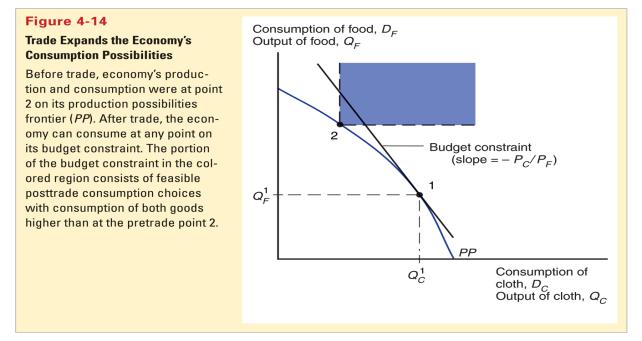
 Because an economy can afford to consume more with trade, the country as a whole is made better off.
Because an economy can afford to consume more with trade, the country as a whole is made better off.
 But some do not gain from trade, unless the model accounts for a redistribution of income.
But some do not gain from trade, unless the model accounts for a redistribution of income.
 Trade changes relative prices of goods, which have effects on the relative earnings of labor and land.
Trade changes relative prices of goods, which have effects on the relative earnings of labor and land.
A rise in the price of cloth raises the purchasing power of domestic laborers, but lowers the purchasing power of domestic land owners.
 The model predicts that with trade owners of abundant factors gain, but owners of scarce factors lose.
The model predicts that with trade owners of abundant factors gain, but owners of scarce factors lose.
Factor Price Equalization
 Unlike the Ricardian model, the Heckscher-Ohlin model predicts that factor prices will be equalized among countries that trade.
Unlike the Ricardian model, the Heckscher-Ohlin model predicts that factor prices will be equalized among countries that trade.
56
 Because relative prices are equalized and because of the direct relationship between relative prices and factor prices, factor prices are also equalized.
Because relative prices are equalized and because of the direct relationship between relative prices and factor prices, factor prices are also equalized.
 Trade increases the demand for goods produced by abundant factors, indirectly increasing the demand for the abundant factors themselves, raising the factor prices of the abundant factors across countries.
Trade increases the demand for goods produced by abundant factors, indirectly increasing the demand for the abundant factors themselves, raising the factor prices of the abundant factors across countries.
 But factor prices are not really equal across countries.
But factor prices are not really equal across countries.
 The model predicts that trading countries produce the same goods, so that prices for those goods can equalize, but countries may produce different goods.
The model predicts that trading countries produce the same goods, so that prices for those goods can equalize, but countries may produce different goods.
 The model assumes that trading countries have the same technology, but different technologies could affect the productivities of factors and therefore the wages/rates paid to these factors.
The model assumes that trading countries have the same technology, but different technologies could affect the productivities of factors and therefore the wages/rates paid to these factors.
 Trade barriers and transportation costs may prevent goods prices and factor prices from equalizing.
Trade barriers and transportation costs may prevent goods prices and factor prices from equalizing.
 After an economy liberalizes trade, factors of production may not quickly move to the industries that intensively use abundant factors.
After an economy liberalizes trade, factors of production may not quickly move to the industries that intensively use abundant factors.
In the short run, the productivity of factors will be determined by their use in their current industry, so that their wage/rate may vary across countries.
Does Trade Increase Income Inequality?
 Over the last 40 years, countries like South Korea, Mexico and China have exported to the US goods intensive in unskilled labor (e.g., clothing, shoes, toys, assembled goods).
Over the last 40 years, countries like South Korea, Mexico and China have exported to the US goods intensive in unskilled labor (e.g., clothing, shoes, toys, assembled goods).
 At the same time, income inequality has increased in the US, as wages of unskilled workers have grown slowly compared to those of skilled workers.
At the same time, income inequality has increased in the US, as wages of unskilled workers have grown slowly compared to those of skilled workers.
57
 Did the former trend cause the latter trend?
Did the former trend cause the latter trend?
 The Heckscher-Ohlin model predicts that owners of abundant factors will gain from trade and owners of scarce factors will lose from trade.
The Heckscher-Ohlin model predicts that owners of abundant factors will gain from trade and owners of scarce factors will lose from trade.  But little evidence supporting this prediction exists.
But little evidence supporting this prediction exists.
1.According to the model, a change in income distribution occurs through changes in goods prices, but there is no evidence of a change in the prices of skill-intensive goods relative to prices of unskilledintensive goods.
2.According to the model, wages of unskilled workers should increase in unskilled labor abundant countries relative to wages of skilled labor, but in some cases the reverse has occurred:
Wages of skilled labor have increased more rapidly in Mexico than wages of unskilled labor.
3.Even if the model were exactly correct, trade is a small fraction of the US economy, so its effects on US prices and wages prices should be small.
Trade and Income Distribution
 Changes in income distribution occur with every economic change, not only international trade.
Changes in income distribution occur with every economic change, not only international trade.
Changes in technology, changes in consumer preferences, exhaustion of resources and discovery of new ones all affect income distribution.
Economists put most of the blame on technological change and the resulting premium paid on education as the major cause of increasing income inequality in the US.
 It would be better to compensate the losers from trade (or any economic change) than prohibit trade.
It would be better to compensate the losers from trade (or any economic change) than prohibit trade.
58

The economy as a whole does benefit from trade.
 There is a political bias in trade politics: potential losers from trade are better politically organized than the winners from trade.
There is a political bias in trade politics: potential losers from trade are better politically organized than the winners from trade.
Losses are usually concentrated among a few, but gains are usually dispersed among many.
Each of you pays about $8/year to restrict imports of sugar, and
the total cost of this policy is about $2 billion/year.
The benefits of this program total about $1 billion, but this amount goes to relatively few sugar producers.
Empirical Evidence of the Heckscher-Ohlin Model
 Tests on US data
Tests on US data
Leontief found that US exports were less capital-intensive than US imports, even though the US is the most capital-abundant country in the world: Leontief paradox.
 Tests on global data
Tests on global data
Bowen, Leamer, and Sveikauskas tested the Heckscher-Ohlin model on data from 27 countries and confirmed the Leontief paradox on an international level.
 Tests on manufacturing data between low/middle income countries and high income countries.
Tests on manufacturing data between low/middle income countries and high income countries.
This data lends more support to the theory.
59
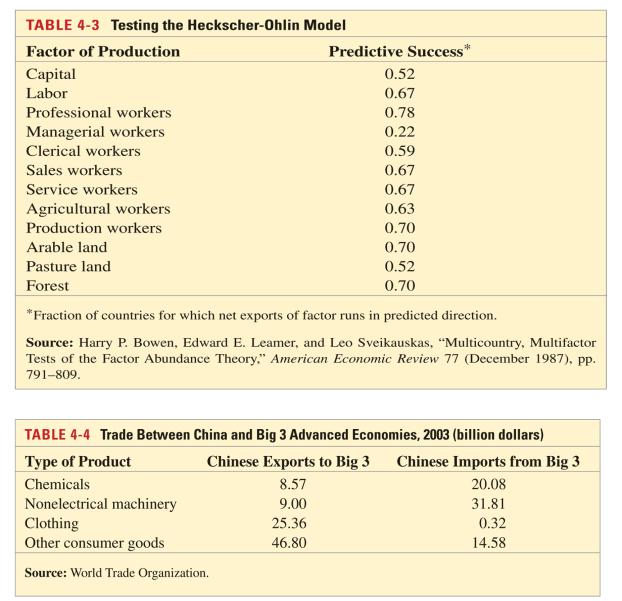
 Because the Heckscher-Ohlin model predicts that factor prices will be equalized across trading countries, it also predicts that factors of production will produce and export a certain quantity goods until factor prices are equalized.
Because the Heckscher-Ohlin model predicts that factor prices will be equalized across trading countries, it also predicts that factors of production will produce and export a certain quantity goods until factor prices are equalized.
In other words, a predicted value of services from factors of production will be embodied in a predicted volume of trade between countries.
 But because factor prices are not equalized across countries, the predicted volume of trade is much smaller than actually occurs.
But because factor prices are not equalized across countries, the predicted volume of trade is much smaller than actually occurs.
A result of ―missing trade‖ discovered by Daniel Trefler.
60
